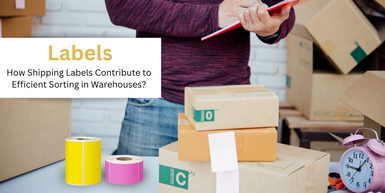Posted by Label Warehouse on 15th Jan 2024
How Shipping Labels Contribute to Efficient Sorting in Warehouses?
Efficient sorting of packages stands as the cornerstone of seamless logistics and supply chain management, playing a pivotal role in the swift and accurate movement of goods from point of origin to destination. In an era defined by global commerce and rapid delivery expectations, the significance of efficient sorting cannot be overstated. Timely and precise sorting not only ensures that products reach their intended recipients on schedule but also optimises overall operational efficiency. This streamlined process minimises the risk of errors, reduces transit times, and enhances customer satisfaction. Moreover, efficient sorting is instrumental in preventing bottlenecks within distribution networks, allowing for a continuous flow of goods and preventing disruptions that could potentially ripple through the entire supply chain. As the heartbeat of modern commerce, efficient package sorting not only elevates the performance of individual warehouses but also contributes to the overall resilience and agility of the broader logistics and supply chain ecosystem.
One often overlooked yet indispensable tool in this process is the humble shipping label. Beyond merely identifying the destination of a package, shipping labels play a pivotal role in the efficient sorting of goods within warehouses, ensuring that items reach their final destination accurately and promptly.
In this blog, we have discussed how shipping labels help in efficient sorting in warehouses.
Let’s begin!
What are Shipping Labels?
Shipping labels are adhesive tags or shipping stickers affixed to packages, boxes, or parcels, providing crucial information about the shipment. Serving as a vital component of the logistics and supply chain process, these labels typically include details such as the sender's and recipient's addresses, package dimensions, weight, and tracking information. The information encoded on a shipping label acts as a unique identifier for each package, facilitating its smooth and accurate movement throughout the shipping and sorting process. In addition to serving as an address label, shipping labels are integral to automated sorting systems within warehouses and distribution centres. Modern shipping labels often incorporate barcodes or QR codes, enabling automated scanners to quickly and accurately capture information, contributing to the efficiency of sorting processes. Beyond their functional role, shipping labels are crucial for inventory management, order fulfilment, and tracking, ensuring that packages are routed correctly and reach their destination in a timely manner.
Different Types of Shipping Labels
Address Labels
The most fundamental type, containing information about the sender and recipient addresses.
Barcode Labels
Include machine-readable barcodes or QR codes that encode essential information for automated scanning and sorting.
Return Labels
Facilitate the return process by providing return addresses and instructions, streamlining reverse logistics.
Fragile Labels
Highlight packages containing delicate or breakable items, alerting handlers to exercise extra care during transportation and sorting.
Hazardous Materials Labels
Essential for packages containing potentially dangerous substances, ensuring compliance with safety regulations and facilitating proper handling.
Temperature-Sensitive Labels
Indicate if the contents require specific temperature conditions during transit, crucial for industries like pharmaceuticals and food.
Special Handling Labels
Highlight packages with unique handling requirements, such as those requiring careful stacking or avoiding exposure to certain elements.
Custom Labels
Tailored labels that may include branding elements, promotional messages, or specific instructions relevant to the shipper or recipient.
Packing Slip Labels
Combine shipping information with an attached packing slip for easy reference, streamlining order fulfilment processes.
Sequential Number Labels
Include unique serial numbers to aid in tracking and inventory management, ensuring each package is distinct and traceable.
Blank Labels
Generic labels that allow shippers to manually write or affix additional information as needed, offering flexibility for various situations.
Integrated Labels
Combine a shipping label with other documents, such as an invoice or packing slip, reducing paperwork and streamlining the shipping process.
Radio-Frequency Identification (RFID) Labels
Incorporate RFID technology for advanced tracking, allowing for real-time monitoring of the package's location and status.
Document Pouch Labels
Include a transparent pouch for documents like invoices or customs forms, ensuring important paperwork remains with the package throughout transit.
International Shipping Labels
Comply with specific international shipping requirements, including fields for customs information, duty details, and other necessary documentation.
How Shipping Labels Contribute to Efficient Sorting in Warehouses?
Shipping labels play a critical role in facilitating efficient sorting processes within warehouses.
Here's how they contribute to the seamless flow of packages through warehouse operations:
Automated Identification
Shipping labels are equipped with essential information such as sender and recipient addresses, package dimensions, and tracking details. Automated sorting systems within warehouses use this information to quickly and accurately identify each package as it moves through conveyor belts or sorting equipment.
Barcode Scanning
Many shipping labels incorporate barcodes or QR codes. Automated scanners read these codes, enabling rapid data capture. This technology significantly expedites the sorting process by eliminating the need for manual data entry and reducing the risk of human errors associated with traditional methods.
Sorting Directives
The information on shipping labels serves as a set of instructions for automated sorting systems. Based on the data provided, these systems determine the correct destination for each package. This allows for efficient routing, minimising the time packages spend in the warehouse and ensuring timely dispatch.
Real-Time Tracking
Shipping labels with tracking information contribute to real-time visibility. Warehouse management systems can monitor the movement of packages throughout the facility, providing valuable insights into the status and location of each item. This visibility enhances overall warehouse efficiency and enables proactive management of potential issues.
Streamlined Cross-Docking
For facilities involved in cross-docking, where products are transferred directly from inbound to outbound shipments without long-term storage, shipping labels are crucial. They enable quick identification and redirection of items, ensuring that goods reach their final destinations without unnecessary delays.
Error Reduction
Accurate information on shipping labels minimises the risk of misplacement or misrouting. By relying on the encoded details, warehouses can significantly reduce errors in sorting, leading to improved order accuracy and customer satisfaction.
Enhanced Inventory Management
Shipping labels act as unique identifiers for each package. As packages move through the sorting process, the warehouse management system updates inventory records in real-time. This accuracy in inventory management helps prevent stockouts, overstock situations, and allows for more precise demand forecasting.
Facilitation of Returns
In case of returned items, shipping labels with return instructions and addresses enable warehouses to quickly identify and process these packages. This streamlines the returns process, ensuring efficient reintroduction of items into inventory and reducing the overall impact on the supply chain.
How to Choose the Right Shipping Label or Your Warehousing Needs?
Choosing the right shipping label for your warehousing needs is crucial for ensuring smooth and efficient logistics operations.
Here are key considerations to help you make an informed decision:
Label Material
Consider the environmental conditions your packages will encounter. Paper labels are suitable for dry environments, while synthetic labels are more durable and weather-resistant, making them ideal for challenging conditions.
Adhesive Strength
Evaluate whether you need labels that adhere permanently or can be easily removed. For items with sensitive surfaces or if reusing packaging is a concern, removable labels may be preferred.
Shipping Label Size and Format
Determine if standard shipping label sizes meet your requirements or if custom sizes are necessary to accommodate specific packaging dimensions. Custom labels can also include branding elements or additional information.
Print Technology
Choose between direct thermal labels (suitable for short-term use) and thermal transfer labels (more durable and suitable for long-term storage). Consider the equipment you have for label printing.
Barcode Compatibility
Ensure that your labels are compatible with the barcode technology used in your warehouse. 2D barcodes, such as QR codes, offer more data storage capacity and may be preferable for certain applications.
Colour Coding
If colour coding is essential for your sorting process, choose labels that support colour printing. Monochrome labels may be sufficient for basic information but might lack the visual cues needed for efficient sorting.
Durability
Consider the environmental factors your packages might encounter during transit and storage, such as exposure to moisture, heat, or chemicals. Choose labels with appropriate durability to withstand these conditions.
Compliance Requirements
Ensure that your chosen labels comply with any industry or regulatory standards. This is particularly important for shipping hazardous materials or international shipments subject to specific labelling requirements.
Integration with Technology
If your warehouse utilises RFID technology for tracking, choose labels that are RFID-compatible. This enables seamless integration with your tracking and inventory management systems.
Cost Considerations
Strike a balance between your budget constraints and the quality of labels needed for your operations. Cheaper labels may save costs initially but may compromise durability and readability over time.
Supplier Reputation
Choose a reputable supplier with a track record of providing high-quality labels. Check for reviews and testimonials to ensure reliability and consistency in product quality.
Wrapping Up,
In the intricate dance of logistics, shipping labels emerge as unsung heroes, silently guiding packages through the complex web of warehouse operations. Their role extends far beyond mere identification; shipping labels are the enablers of efficiency, supporting automated sorting, enhancing inventory management, streamlining returns, and promoting sustainability. As warehouses continue to evolve with technological advancements, the importance of shipping labels in ensuring the smooth flow of goods cannot be overstated. In the grand symphony of supply chain logistics, shipping labels play a vital melody that harmonises the efficiency of warehouse sorting processes.
Are you looking for premium quality shipping labels or shipping stickers at the best prices online in Australia?
If yes, then look no further!
Label Warehouse is your go-to destination for premium shipping labels, available at competitive prices. Visit our website and shop for the perfect shipping labels for your warehousing needs today!

